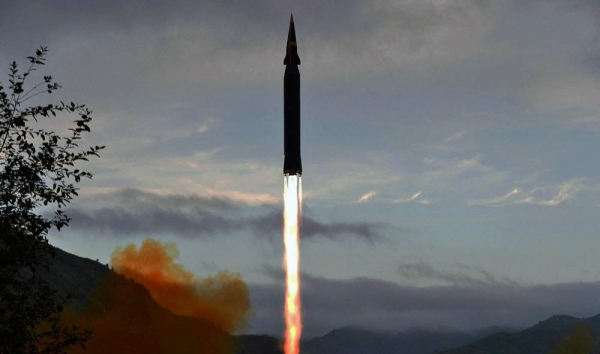
TOKYO — North Korea's newly unveiled "hypersonic missile" appears to be at an early stage of development and can be intercepted by South Korean and US military assets, Seoul's military said Wednesday, according to Yonhap News Agency.
The assessment came hours after the North's official Korean Central News Agency said the country conducted the first test fire of the hypersonic Hwasong-8 missile from Toyang-ri, Jagang Province, on Tuesday.
"Given the detected speed and other features of the 'hypersonic missile' North Korea said it test-fired Tuesday, it appears to be at an early stage of development that would require considerable time for actual deployment," the Joint Chiefs of Staff (JCS) said in a statement.
Hypersonic missiles usually fly at a speed of at least Mach 5, or 6,125 km per hour, and are capable of striking targets from longer ranges within a shorter period of time, giving little time for enemies to respond.
The US, China and Russia are also developing the hypersonic weapon.
"South Korea and the US were monitoring North Korea's test launch under a close coordination," a JCS official said, adding that the military will keep tabs on the North's missile activities and maintain a readiness posture.
It was the first test-launch, in which the country's Academy of Defense Science ascertained the stability of the engine as well as missile fuel ampoule that has been introduced for the first time, the KCNA reported.
The test-launch came after the North Korea tested cruise and ballistic missiles earlier this month.
North Korea said Wednesday that the weapon it tested a day earlier was a new “hypersonic missile” that can better evade defenses compared to ballistic missiles and be quickly deployed in the event of conflict.
The development of the new weapons system, which the North’s state-run Korean Central News Agency called a Hwasong-8, had been “a top priority” of the regime and was an achievement “of great strategic significance” — a term often used to denote nuclear capabilities.
Hypersonic missiles are far faster and more maneuverable than ballistic ones, making them potentially difficult targets for missile defenses. The North has in recent years developed a spate of missiles better equipped at evading enemies’ defenses.
The new weapon was still expected to generate concern in Tokyo, potentially prompting Japan to review missile defense policies, observers said.
Malcolm Davis, a senior analyst at the Australian Strategic Policy Institute, said that the “likely targets” of the weapon would be US bases in the region, including those in Japan.
Japan’s top government spokesman said Wednesday that Tokyo was aware of the claim, but was continuing to collect and analyze information with the US and others.
Chief Cabinet Secretary Katsunobu Kato told a regular news conference that Japan was currently working to “improve its abilities to detect, track, and intercept all threats from the air.”
“We are planning to continue to strengthen the comprehensive missile air defense capabilities that we operate in Japan,” he added.
A hypersonic glide vehicle is launched aboard a missile before it separates and approaches a target. HGVs can change trajectory during flight, making it difficult to intercept.
The North also said the missile had employed a “fuel ampoule” for the first time, suggesting the weapons could be fueled in factories and then sent to units in canisters.
Doing so would allow a higher-degree of stealth for the weapons in the event of a conflict, eliminating the time-consuming need to fuel missiles at launch sites and potentially preventing the weapons from being spotted and targeted by spy satellites.
KCNA said that top military official and politburo presidium member Pak Jong Chon, who oversaw the launch, “noted the military significance of turning all missile fuel systems into ampoules.”
“If the DPRK fuels the missiles in the factory, military units don’t have to spend time doing it in the field when the @usairforce is doing its level best to kill them,” Jeffrey Lewis, a weapons expert and professor at the Middlebury Institute of International Studies, wrote on Twitter. “The canister also provides temperature control for the oxidizer. Big step for (North Korea).”
Details — including the estimated distance and height that the missile had traveled — have not been publicly released, but South Korean media, quoting military sources there, said the missile had “different flight features” than previously seen and was believed to have traveled 200 kilometers and hit a maximum altitude of around 30 km. — Agencies